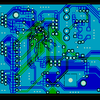System design document: https://docs.google.com/document/d/1FCr_1DzBJ3AlNbu3_3PSzmd7HQe7VcK2Rn7YlFluygg/edit?pli=1
There's really not much more to say than is contained in the description and the aforementioned document. The whole thing is an ARM core sampling the amplified output of a microphone, running an FFT, matching the dominant pitch to a note value, then lighting an LED to indicate whether the pitch is in tune. Not terribly complicated.
The fancy part of the project is the form factor- the goal is to make it look really nice, hence the CNC-milled aluminum enclosure.
 dbtayl
dbtayl




 Now it's on to firmware and (back to) electronics.
Now it's on to firmware and (back to) electronics.










 gannon
gannon
 zakqwy
zakqwy
 Kenneth Marut
Kenneth Marut
 Chaz
Chaz
Am I right in thinking you're using software FFT (cause it's a Cortex M3)? If so, what's the clock speed on that chip? Is it quick and responsive in use or a little laggy? Great project! Love the enclosure.